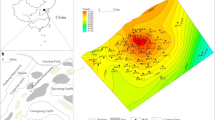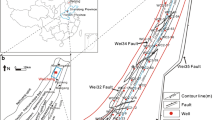Abstract
To reduce or avoid some of the ambiguities in a heterogeneous reservoir, a fine three-dimensional model would be inevitably established with the application of geostatistical techniques. BD oilfield is a low-permeability fractured reservoir with many fracture types, which composes a multi-azimuthal fracture system, causing strong anisotropy and heterogeneity. Moreover, fracture provides not only accumulation space for oil and gas but also channels for migration of hydrocarbons and water dashing and thus plays a leading role in controlling BD reservoir production. With the continuous exploitation of oil in reservoir for more than 30 years, BD oilfield has currently stepped into high water cut stage, exposing many problems such as low oil recovery, poor exploitation stability, rapid oil production decline, and one-way water intrusion. Therefore, a detailed reservoir characterization, constructed to describe reservoir behavior under strong water drive in a well-developed fractured reservoir, is urgently needed. In this study, combined with three-dimensional geostatistical techniques, an accurate and efficient reservoir parameter model that occurs in a strong heterogeneous fractured reservoir has been constructed through stratigraphic correlation and sedimentary facies analysis. Hence, all the study presented above will be available for well location, remaining oil potential-tapping and oil recovery improvement during the later study work.










Similar content being viewed by others
References
Al Bulushi NI, King PR, Blunt MJ, Kraaijveld M (2012) Artificial neural networks workflow and its application in the petroleum industry. Neural Comput Appl 21(3):409–421
Archer J.S., C.G. Wall. Petroleum engineering principles and practice [M].1992: 140–153
Bhatt A, Helle HB (2002) Determination of facies from well logs using modular neural networks [J]. Pet Geosci 8:217–228
Chen Y, Durlofsky LJ (2006) Adaptive local–global upscaling for general flow scenarios in heterogeneous formations. Transp Porous Media 62:157–185
Deutsch CV (2002) Geostatistical reservoir modeling [M. Oxford University Press, New York
Durlofsky LJ, Jones RC, Milliken WJ (1997) A nonuniform coarsening approach for the scale up of displacement processes in heterogeneous media. Adv Water Resour 20:335–347
Fegh A, Riahi MA, Norouzi GH (2013) Permeability prediction and construction of 3D geological model: application of neural networks and stochastic approaches in an Iranian gas reservoir [J]. Neural Comput Applic 23:1763–1770
Haykin S (1999) Neural networks: a comprehensive foundation [M]. Prentice Hall, London, pp. 20–25
Isaaks EH, Srivastava RM (1989) An introduction to applied geostatistics [M. Oxford University Press, New York
James W, Jennings JR, Jerry LF (2003) Predicting permeability from well logs in carbonates with a link to geology for inter-well permeability mapping. SPE Reserv Eval Eng 6(4):215–225
Kulpecz AA, van Geuns LC (1990) Geological modeling of a turbidite reservoir, Fortier field, North Sea. Sandstone Petroleum Reservoirs:489–507
Laine E (2014) Geological 3D modeling (process) and future needs for 3D data and model storage at geological survey of Finland. Mathematics of Planet Earth 839-842
Mao F, An’ding C, Yuanfeng Y et al (2006) Hydrocarbon accumulation characteristics and seismic recognition technology of complex small fault block in northern Jiangsu basin [J]. Oil Gas Geol 27(6):828
Monsen E, Randen T, Sønnelan L (2005) Geological model building: a hierarchical segementation approach [J]. Math Methods Model Hydrocarb Explor Prod 7:213–245
Seifert D, Jensen JL (1999) Using sequential indicator simulation as a tool in reservoir description: issues and uncertainties. Math Geol 31(5):527–550
Sun L, Liu J, Mao J et al (2010) The application of injection profile data in the low permeability reservoir development [J]. Petrochem Ind Appl 29(12):44–46
Tao J, Xu L, Huang J, Yu B Research on the prediction of the geological spatial information using gray GIS modeling method based on the borehole data and the geologic map [J]. Geo-Informatics in Resource Management and Sustainable Ecosystem 399:107–115
Tureyen OI, Caers J (2005) A parallel, multiscale approach to reservoir modeling. Comput Geosci 9:75–98
Turner AK (1989) The role of three dimensional geographic information systems in subsurface characterization for hydrogeological applications. In: Raper JF (ed) Three-dimensional applications in geographic information systems. Taylor and Francis, London, pp. 115–127
Turner AK (2000) Geoscientific modelling: past, present and future. In: Coburn TC, Yarus JM (eds) geographic information systems in petroleum exploration and development. AAPG computer applications in geology. American Association Petroleum Geologists 4:27–36
Turner AK (2006) Challenges and trends for geological modelling and visualization [J]. Bull Eng Geol Env 65:109–127
Wang Y, Liu B, Gao J, Zhang X, Li S, Liu J, Tian Z (2015) Auto recognition of carbonate microfacies based on an improved back propagation neural network [J]. J Cent South Univ 22:3521–3535
Wenlong X., Tran T., Srivastava R.M., Journel A.G.. Integrating seismic data in reservoir modeling: The Collocated Cokriging Alternative. In: the 67th annual technical conference and exhibition of the society of petroleum engineers, Washington, 1992, 4–7.
Yeten B, Gumrah F (2000) The use of fractal geostatistics and artificial neural networks for carbonate reservoir characterization. Transp Porous Media 41:173–195
Zhang Q, Xu S, Yu W, Cheng H (2011) Application of particle swarm optimization to kriging three dimensional geological modeling. Journal of Daqing Petroleum Institute 35(1):85–89
Zhao C, Zhu X (2001) Sedimentary petrology[M]. Petroleum Industry Press, Beijing
Zheng G, Shen Y (2004) 3D analyses of geological characteristics and status research of 3D geology modeling. Adv Earth Sci 19(2):218–223
Acknowledgments
This study was carried out under the supervision and permission of SINOPEC Jiangsu Oilfield Geology Research Institute. This research involves part of my dissertation which stems from specialized research fund for the Doctoral Program of Higher Education (No. 20110003110014). Funding was provided by major projects supported by the Natural Science Research of Jiangsu Higher Education Institutions (No.16KJA170004). The authors would like to thank all the researchers for financially supporting the research project. Special thanks are extended to Dr. Yanmei Huang and Bo Lin for their help and comments on the study. We would also like to express our sincere thanks to anonymous reviewers and the Editor for their comments and suggestions that significantly improved the quality of this paper.
Author information
Authors and Affiliations
Corresponding author
Rights and permissions
About this article
Cite this article
Li, X., Zhang, J., Liu, L. et al. Three-dimensional reservoir architecture modeling by geostatistical techniques in BD block, Jinhu depression, northern Jiangsu Basin, China. Arab J Geosci 9, 654 (2016). https://doi.org/10.1007/s12517-016-2694-1
Received:
Accepted:
Published:
DOI: https://doi.org/10.1007/s12517-016-2694-1




